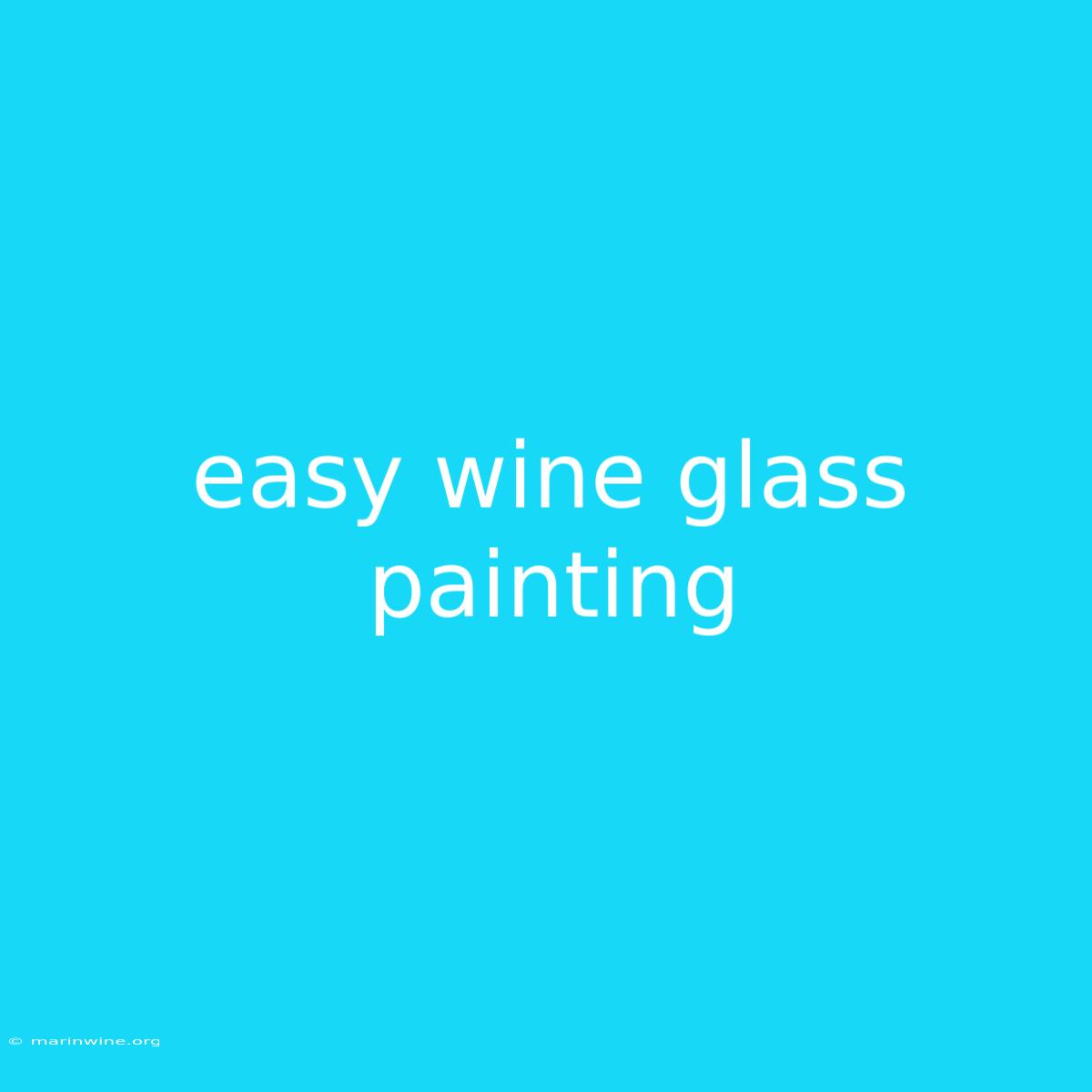Unleash Your Inner Artist: Easy Wine Glass Painting for Beginners
Have you ever admired beautifully painted wine glasses but felt intimidated to try it yourself? It's time to ditch those doubts and embrace the fun and simplicity of wine glass painting! This beginner-friendly guide will equip you with everything you need to create stunning masterpieces, even if you've never picked up a paintbrush before.
Why It Matters
Wine glass painting is more than just a fun craft; it's a fantastic way to personalize your home décor, create unique gifts for loved ones, and even boost your creativity! Whether you're looking to add a touch of whimsy to your dining table or create personalized gifts for special occasions, wine glass painting opens up a world of possibilities.
Key Takeaways of Wine Glass Painting:
| Feature | Description |
|---|---|
| Ease of Access | Requires minimal supplies and is relatively inexpensive |
| Creative Expression | Allows for endless personalization and artistic freedom |
| Versatility | Can be used for various occasions and purposes |
| Durability | When done correctly, painted glasses can be dishwasher-safe |
Wine Glass Painting: A Beginner's Guide
Materials Needed
- Wine Glasses: Choose plain, clear glasses for the best results.
- Acrylic Paints: Choose non-toxic acrylic paints specifically designed for glass.
- Paintbrushes: Select brushes in various sizes and shapes to create different effects.
- Glass Etching Cream: Optional, but it helps create a smooth, permanent surface for the paint.
- Painter's Tape: Useful for creating clean lines and precise patterns.
- Cleaning Supplies: Include rubbing alcohol, cotton balls, and a dishcloth.
- Optional: Stencils, glitter, or other decorative elements for added flair.
Getting Started
- Clean Your Glasses: Thoroughly wash and dry your wine glasses using rubbing alcohol to remove any residue or fingerprints.
- Apply Glass Etching Cream (Optional): If using, follow the instructions on the etching cream package carefully.
- Tape Off Areas (Optional): Use painter's tape to create clean lines or geometric patterns.
- Start Painting: Using your chosen paint colors, begin applying the paint to the glass. Use thin coats for a smooth finish, and allow each coat to dry completely before applying the next.
- Add Details and Decorations (Optional): Once your base coat is dry, add details, patterns, or decorative elements like glitter or stencils.
- Seal the Paint (Optional): For a more durable finish, apply a sealant specially designed for glass.
- Let It Dry: Allow the paint to dry completely before using or washing the glasses.
Key Aspects of Wine Glass Painting
1. Choosing the Right Paints
- Acrylic Paints: Acrylics are the most popular choice for wine glass painting due to their durability, fast drying time, and easy application. Look for paints specifically designed for glass and ensure they are non-toxic.
- Glass Etching Cream: While optional, etching cream provides a smoother surface for the paint to adhere to, creating a longer-lasting and dishwasher-safe finish.
2. Techniques and Styles
- Freehand Painting: This technique allows for creative freedom and personalized designs. It's best for those comfortable with sketching and painting.
- Stenciling: Stencils provide a convenient way to create clean lines and intricate patterns, ideal for beginners.
- Decoupage: This technique involves applying decorative paper or fabric to the glass surface. It can be used to create a variety of designs, including vintage or rustic aesthetics.
- Glitter and Embellishments: Adding glitter, beads, or other decorative elements can enhance the visual appeal and create unique designs.
3. Durability and Care
- Dishwasher Safety: Although some glass paints claim to be dishwasher-safe, it's always best to handwash painted glasses to ensure their longevity.
- Proper Sealing: Applying a sealant designed for glass can significantly enhance the paint's durability and protect it from scratches and fading.
FAQ
Q: Can I use regular acrylic paints on wine glasses?
A: While regular acrylic paints may work initially, they are not as durable or resistant to dishwasher use as paints specifically designed for glass.
Q: Do I need to use etching cream?
A: Etching cream is optional but recommended for a smoother surface and more permanent paint adherence.
Q: How long do I need to wait for the paint to dry?
A: Allow each coat of paint to dry completely before applying the next. Drying times vary depending on the paint and humidity levels.
Q: What kind of sealant should I use?
A: Look for a sealant specifically designed for glass.
Q: Can I use painted wine glasses in the dishwasher?
A: It's best to handwash painted wine glasses to ensure their longevity.
Tips for Easy Wine Glass Painting
- Start with Simple Designs: Begin with simple designs like dots, stripes, or geometric patterns before moving onto more complex ones.
- Practice on Scrap Paper: Before painting on the actual glass, practice your design on scrap paper to get a feel for the paint and brush strokes.
- Use Thin Coats: Apply paint in thin coats to avoid smudging or running.
- Clean Up Mistakes Quickly: If you make a mistake, use a cotton swab dipped in rubbing alcohol to remove the paint before it dries.
- Have Fun and Experiment!: Don't be afraid to experiment with different colors, techniques, and embellishments. There are no rules when it comes to creativity!
Summary by Easy Wine Glass Painting
From simple swirls to intricate designs, wine glass painting offers a fulfilling and visually appealing craft for individuals of all skill levels. The ease of access, versatility, and creative freedom make it a perfect activity for personal enjoyment or sharing with friends and family. So grab your materials, let your imagination run wild, and transform ordinary wine glasses into stunning artistic expressions!

